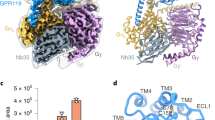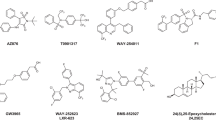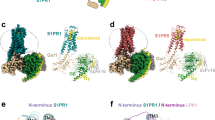Abstract
The human nuclear receptor liver receptor homolog-1 (LRH-1) has an important role in controlling lipid and cholesterol homeostasis and is a potential target for the treatment of diabetes and hepatic diseases. LRH-1 is known to bind phospholipids, but the role of phospholipids in controlling LRH-1 activation remains highly debated. Here we describe the structure of both apo LRH-1 and LRH-1 in complex with the antidiabetic phospholipid dilauroylphosphatidylcholine (DLPC). Together with hydrogen-deuterium exchange MS and functional data, our studies show that DLPC binding is a dynamic process that alters co-regulator selectivity. We show that the lipid-free receptor undergoes previously unrecognized structural fluctuations, allowing it to interact with widely expressed co-repressors. These observations enhance our understanding of LRH-1 regulation and highlight its importance as a new therapeutic target for controlling diabetes.
This is a preview of subscription content, access via your institution
Access options
Subscribe to this journal
Receive 12 print issues and online access
$189.00 per year
only $15.75 per issue
Buy this article
- Purchase on Springer Link
- Instant access to full article PDF
Prices may be subject to local taxes which are calculated during checkout




Similar content being viewed by others
References
Lee, J.M. et al. A nuclear-receptor-dependent phosphatidylcholine pathway with antidiabetic effects. Nature 474, 506–510 (2011).
Ortlund, E.A. et al. Modulation of human nuclear receptor LRH-1 activity by phospholipids and SHP. Nat. Struct. Mol. Biol. 12, 357–363 (2005).
Krylova, I.N. et al. Structural analyses reveal phosphatidyl inositols as ligands for the NR5 orphan receptors SF-1 and LRH-1. Cell 120, 343–355 (2005).
Li, Y. et al. Structural and biochemical basis for selective repression of the orphan nuclear receptor liver receptor homolog 1 by small heterodimer partner. Proc. Natl. Acad. Sci. USA 102, 9505–9510 (2005).
Fernandez-Marcos, P.J., Auwerx, J. & Schoonjans, K. Emerging actions of the nuclear receptor LRH-1 in the gut. Biochim. Biophys. Acta 1812, 947–955 (2011).
Lee, Y.K. & Moore, D.D. Liver receptor homolog-1, an emerging metabolic modulator. Front. Biosci. 13, 5950–5958 (2008).
Parker, K.L. & Schimmer, B.P. Steroidogenic factor 1: a key determinant of endocrine development and function. Endocr. Rev. 18, 361–377 (1997).
Wagner, R.T., Xu, X., Yi, F., Merrill, B.J. & Cooney, A.J. Canonical Wnt/beta-catenin regulation of liver receptor homolog-1 mediates pluripotency gene expression. Stem Cells 28, 1794–1804 (2010).
Gu, P. et al. Orphan nuclear receptor LRH-1 is required to maintain Oct4 expression at the epiblast stage of embryonic development. Mol. Cell Biol. 25, 3492–3505 (2005).
Clyne, C.D., Speed, C.J., Zhou, J. & Simpson, E.R. Liver receptor homologue-1 (LRH-1) regulates expression of aromatase in preadipocytes. J. Biol. Chem. 277, 20591–20597 (2002).
Clyne, C.D. et al. Regulation of aromatase expression by the nuclear receptor LRH-1 in adipose tissue. Mol. Cell Endocrinol. 215, 39–44 (2004).
Zhou, J. et al. Interactions between prostaglandin E-2, liver receptor homologue-1, and aromatase in breast cancer. Cancer Res. 65, 657–663 (2005).
Chand, A.L., Herridge, K.A., Thompson, E.W. & Clyne, C.D. The orphan nuclear receptor LRH-1 promotes breast cancer motility and invasion. Endocr. Relat. Cancer 17, 965–975 (2010).
Annicotte, J.S. et al. The nuclear receptor liver receptor homolog-1 is an estrogen receptor target gene. Oncogene 24, 8167–8175 (2005).
Thiruchelvam, P.T. et al. The liver receptor homolog-1 regulates estrogen receptor expression in breast cancer cells. Breast Cancer Res. Treat. 127, 385–396 (2011).
Nagy, L. & Schwabe, J.W. Mechanism of the nuclear receptor molecular switch. Trends Biochem. Sci. 29, 317–324 (2004).
Goodwin, B. et al. A regulatory cascade of the nuclear receptors FXR, SHP-1, and LRH-1 represses bile acid biosynthesis. Mol. Cell 6, 517–526 (2000).
Sablin, E.P. et al. The structure of corepressor Dax-1 bound to its target nuclear receptor LRH-1. Proc. Natl. Acad. Sci. USA 105, 18390–18395 (2008).
Sablin, E.P., Krylova, I.N., Fletterick, R.J. & Ingraham, H.A. Structural basis for ligand-independent activation of the orphan nuclear receptor LRH-1. Mol. Cell 11, 1575–1585 (2003).
Ingraham, H.A. & Redinbo, M.R. Orphan nuclear receptors adopted by crystallography. Curr. Opin. Struct. Biol. 15, 708–715 (2005).
Xu, P.L., Kong, Y.Y., Xie, Y.H. & Wang, Y. Corepressor SMRT specifically represses the transcriptional activity of orphan nuclear receptor hB1F/hLRH-1. Sheng Wu Hua Xue Yu Sheng Wu Wu Li Xue Bao (Shanghai) 35, 897–903 (2003).
Wang, W. et al. The crystal structures of human steroidogenic factor-1 and liver receptor homologue-1. Proc. Natl. Acad. Sci. USA 102, 7505–7510 (2005).
Li, Y. et al. Crystallographic identification and functional characterization of phospholipids as ligands for the orphan nuclear receptor steroidogenic factor-1. Mol. Cell 17, 491–502 (2005).
Gee, A.C. & Katzenellenbogen, J.A. Probing conformational changes in the estrogen receptor: evidence for a partially unfolded intermediate facilitating ligand binding and release. Mol. Endocrinol. 15, 421–428 (2001).
Yumoto, F. et al. Structural basis of coactivation of liver receptor homolog-1 by β-catenin. Proc. Natl. Acad. Sci. USA 109, 143–148 (2012).
Jasuja, R. et al. Kinetic and thermodynamic characterization of dihydrotestosterone-induced conformational perturbations in androgen receptor ligand-binding domain. Mol. Endocrinol. 23, 1231–1241 (2009).
Venteclef, N. et al. GPS2-dependent corepressor/SUMO pathways govern anti-inflammatory actions of LRH-1 and LXRbeta in the hepatic acute phase response. Genes Dev. 24, 381–395 (2010).
Whitby, R.J. et al. Small molecule agonists of the orphan nuclear receptors steroidogenic factor-1 (SF-1, NR5A1) and liver receptor homologue-1 (LRH-1, NR5A2). J. Med. Chem. 54, 2266–2281 (2011).
Otwinowski, Z. & Minor, W. Processing of X-ray diffraction data collected in oscillation mode. Methods Enzymol. 276, 307–326 (1997).
Murshudov, G.N., Vagin, A.A. & Dodson, E.J. Refinement of macromolecular structures by the maximum-likelihood method. Acta Crystallogr. D Biol. Crystallogr. 53, 240–255 (1997).
Potterton, E., Briggs, P., Turkenburg, M. & Dodson, E. A graphical user interface to the CCP4 program suite. Acta Crystallogr. D Biol. Crystallogr. 59, 1131–1137 (2003).
Emsley, P. & Cowtan, K. Coot: model-building tools for molecular graphics. Acta Crystallogr. D Biol. Crystallogr. 60, 2126–2132 (2004).
Emsley, P., Lohkamp, B., Scott, W.G. & Cowtan, K. Features and development of Coot. Acta Crystallogr. D Biol. Crystallogr. 66, 486–501 (2010).
Chen, V.B. et al. MolProbity: all-atom structure validation for macromolecular crystallography. Acta Crystallogr. D Biol. Crystallogr. 66, 12–21 (2010).
Bligh, E.G. & Dyer, W.J. A rapid method of total lipid extraction and purification. Can. J. Biochem. Physiol. 37, 911–917 (1959).
Zhou, X. & Arthur, G. Improved procedures for the determination of lipid phosphorus by malachite green. J. Lipid Res. 33, 1233–1236 (1992).
Louis-Jeune, C., Andrade-Navarro, M.A. & Perez-Iratxeta, C. Prediction of protein secondary structure from circular dichroism using theoretically derived spectra. Proteins published online, doi:10.1002/prot.23188 (14 September 2011).
Chalmers, M.J. et al. Probing protein ligand interactions by automated hydrogen/deuterium exchange mass spectrometry. Anal. Chem. 78, 1005–1014 (2006).
Acknowledgements
We thank N.T. Seyfried in the Department of Biochemistry at Emory University for his help in acquiring the MS data for the proteolysis protection assays. We thank F.H. Strobel in the Department of Chemistry at Emory University for his help in acquiring the MS data for phospholipids. P.R.G. was supported by NIH grants GM084041 (PI: P.R. Griffin) and MH084512 (PI: H. Rosen). This work was supported with start-up funds from Emory University. P.M.M. was supported by an Emory–National Institute of Environmental Health Sciences Graduate and Postdoctoral Training in Toxicology grant (T32ES012870).
Author information
Authors and Affiliations
Contributions
P.M.M. purified, crystallized and determined both LRH-1 structures, measured phospholipid levels and carried out co-regulator-peptide interaction studies. M.C.P. measured lipid phosphorus levels, optimized apo LRH-1 production and carried out co-regulator peptide interaction studies. W.H.H. conducted reporter gene experiments. J.L.L. and P.R.G. conducted thermal unfolding and HDX experiments. P.M.M., J.L.L., P.R.G. and E.A.O. analyzed and interpreted the data. P.M.M. and E.A.O. conceived the experiments and wrote the manuscript.
Corresponding author
Ethics declarations
Competing interests
The authors declare no competing financial interests.
Supplementary information
Supplementary Text and Figures
Supplementary Figures 1–4, Supplementary Tables 1 and 2, and Supplementary Methods (PDF 10797 kb)
Rights and permissions
About this article
Cite this article
Musille, P., Pathak, M., Lauer, J. et al. Antidiabetic phospholipid–nuclear receptor complex reveals the mechanism for phospholipid-driven gene regulation. Nat Struct Mol Biol 19, 532–537 (2012). https://doi.org/10.1038/nsmb.2279
Received:
Accepted:
Published:
Issue Date:
DOI: https://doi.org/10.1038/nsmb.2279
This article is cited by
-
Analysis of the genetic variants associated with circulating levels of sgp130. Results from the IMPROVE study
Genes & Immunity (2020)
-
A molecular switch regulating transcriptional repression and activation of PPARγ
Nature Communications (2020)
-
LRH-1 mitigates intestinal inflammatory disease by maintaining epithelial homeostasis and cell survival
Nature Communications (2018)
-
HDX reveals the conformational dynamics of DNA sequence specific VDR co-activator interactions
Nature Communications (2017)
-
Biliary Phospholipids Sustain Enterocyte Proliferation and Intestinal Tumor Progression via Nuclear Receptor Lrh1 in mice
Scientific Reports (2016)



